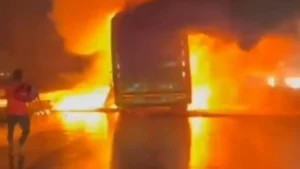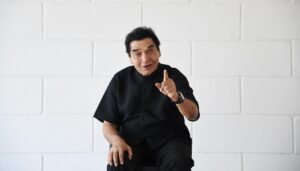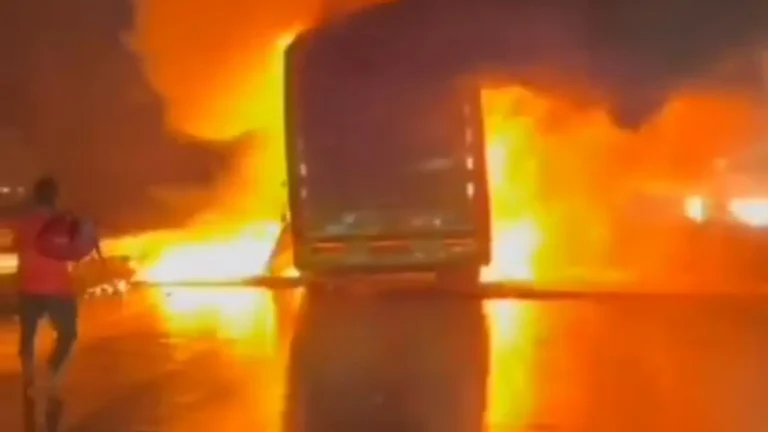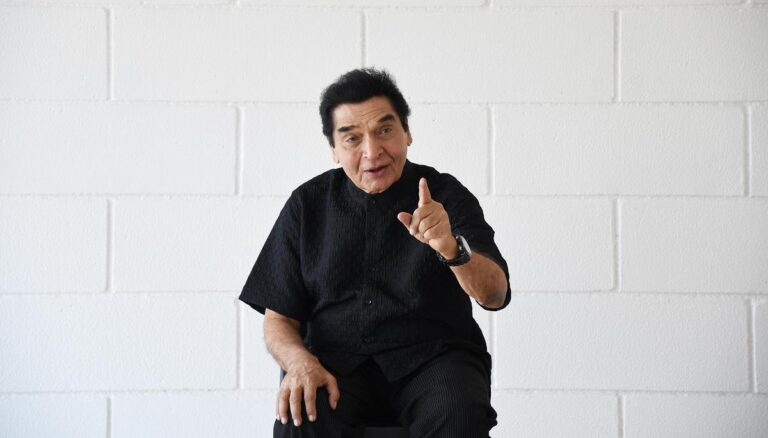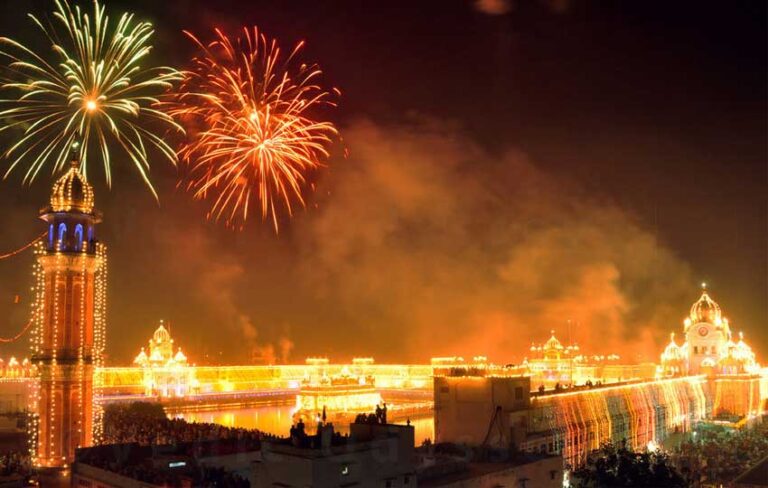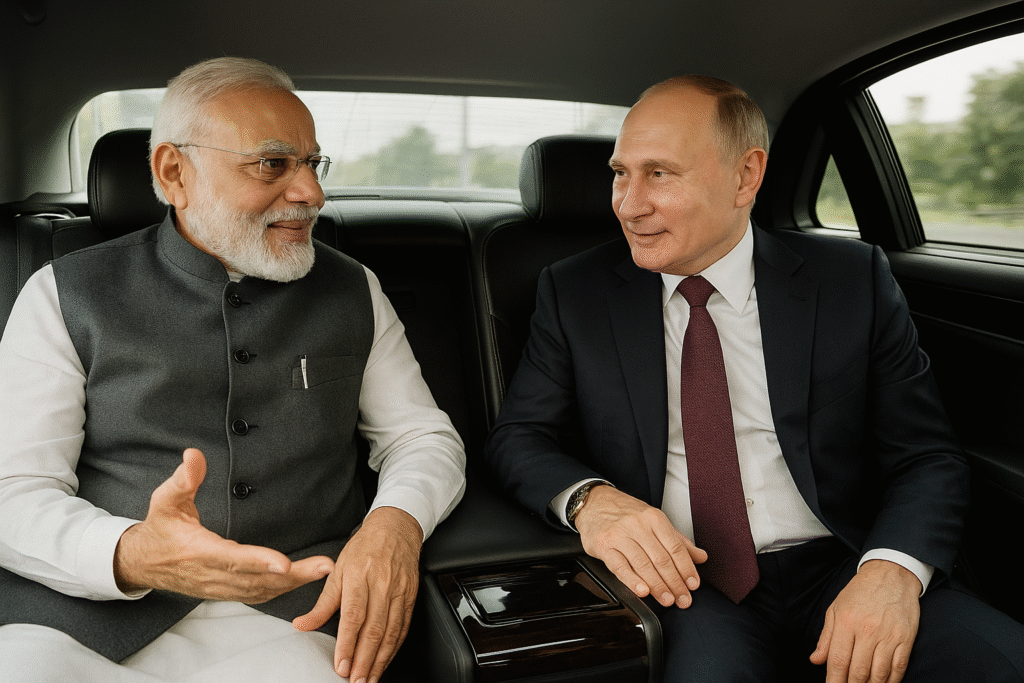
Modi-Putin ,In international diplomacy, symbolism often carries as much weight as formal agreements. The Shanghai Cooperation Organization (SCO) summit in Tianjin became a stage for such symbolism when Indian Prime Minister Narendra Modi and Russian President Vladimir Putin shared an unplanned yet highly significant car ride. Exclusive reports suggest that Putin personally requested to travel with Modi from the conference venue to the bilateral meeting site, a journey that went far beyond protocol.
What unfolded in that car ride and its aftermath reflects not just the growing warmth between India and Russia, but also the subtle shifts in global geopolitics at a time of fractured alliances, economic realignments, and strategic recalibrations.
Putin Waits for Modi: A Gesture of Respect
According to sources, President Putin waited nearly ten minutes for Prime Minister Modi so that the two leaders could ride together. Such patience is unusual in the rigidly choreographed world of summit diplomacy. The ride itself lasted long enough to delay the start of their formal bilateral talks, as both leaders reportedly continued conversing for about 45 minutes even after reaching the hotel.
Though the exact details of their discussion remain private, the optics send a powerful message: Russia places great importance on its personal rapport with India’s leader. Putin’s earlier remark at a BRICS summit—that he and Modi do not need translators to understand each other—captures the depth of their working relationship.
Why This Meeting Matters
The significance of this interaction extends beyond courtesy. India is playing an increasingly pivotal role in global affairs, balancing relations with Russia, the United States, China, and other partners. The SCO, founded by China and Russia with a focus on Central Asian security and counterterrorism, is now evolving into a platform for economic cooperation. For India, it is both an opportunity and a challenge: an opportunity to deepen its regional influence, and a challenge to assert independence amid competing global blocs.
Putin’s choice to highlight his partnership with Modi contrasts sharply with the strained ties Russia maintains with Western leaders. At a time when Moscow is isolated due to its standoff with Ukraine and the West, India emerges as one of the few major powers capable of dialogue with all sides.
The Eurasian Economic Angle
The bilateral meeting between Modi and Putin also revisited a stalled conversation: a potential Free Trade Agreement (FTA) between India and the Eurasian Economic Union (EAEU). This agreement had lingered in limbo for years but is now being revived amid shifting global trade patterns.
Analysts argue that Donald Trump’s tariff policies disrupted established trade flows and pushed many countries, including India, to diversify their economic partnerships. While new markets take years to mature, discussions at the SCO summit signal India’s intent to look beyond its traditional partners.
For New Delhi, strengthening ties with Eurasian economies means greater access to energy resources, logistics corridors, and alternative markets—key steps in reducing over-dependence on any single bloc.
India-US Trade: A Balancing Act
At the same time, India cannot ignore its deep economic ties with the United States. Despite ongoing trade frictions, the U.S. remains one of India’s largest buyers. High-tech services, particularly software and IT solutions, account for over $80 billion in bilateral trade annually. Pharmaceuticals also form a significant component, and both sectors remain largely unaffected by tariff wars.
The pain point lies in textiles, a major employer in India and one of the industries hit hardest by U.S. tariffs. While politically sensitive, this represents just about 2% of India’s GDP. Thus, although the rhetoric around trade disputes has created turbulence, the core of India-U.S. economic relations remains intact.
Yet, the geopolitical angle looms large. Reports that the U.S. president may skip the upcoming Quad summit hosted by India raise questions about the strength of strategic partnerships in the Indo-Pacific. Against this backdrop, Modi’s closeness with Putin acquires even more significance.
A Symbol with Substance
In diplomacy, private conversations often matter as much as official communiqués. The 45 minutes Modi and Putin spent together, away from cameras and delegations, may have laid the groundwork for deeper cooperation in areas ranging from trade to security.
For India, this was an affirmation of its unique role: a trusted interlocutor for Russia, a major partner for the U.S., and a rising force within Asia. For Russia, it was an opportunity to showcase that despite Western isolation, Moscow still enjoys the confidence of influential leaders.
A Symbol with Substance
In diplomacy, private conversations often matter as much as official communiqués. The 45 minutes Modi and Putin spent together, away from cameras and delegations, may have laid the groundwork for deeper cooperation in areas ranging from trade to security.
For India, this was an affirmation of its unique role: a trusted interlocutor for Russia, a major partner for the U.S., and a rising force within Asia. For Russia, it was an opportunity to showcase that despite Western isolation, Moscow still enjoys the confidence of influential leaders.
